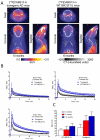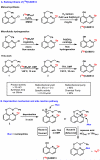PET neuroimaging studies of [(18)F]CABS13 in a double transgenic mouse model of Alzheimer's disease and nonhuman primates
- PMID: 25776827
- PMCID: PMC4879824
- DOI: 10.1021/acschemneuro.5b00055
PET neuroimaging studies of [(18)F]CABS13 in a double transgenic mouse model of Alzheimer's disease and nonhuman primates
Abstract
Fluorine-18 labeled 2-fluoro-8-hydroxyquinoline ([(18)F]CABS13) is a promising positron emission tomography (PET) radiopharmaceutical based on a metal chelator developed to probe the "metal hypothesis of Alzheimer's disease". Herein, a practical radiosynthesis of [(18)F]CABS13 was achieved by radiofluorination followed by deprotection of an O-benzyloxymethyl group. Automated production and formulation of [(18)F]CABS13 resulted in 19 ± 5% uncorrected radiochemical yield, relative to starting [(18)F]fluoride, with ≥95% chemical and radiochemical purities, and high specific activity (>2.5 Ci/μmol) within 80 min. Temporal PET neuroimaging studies were carried out in female transgenic B6C3-Tg(APPswe,PSEN 1dE9)85Dbo/J (APP/PS1) and age-matched wild-type (WT) B6C3F1/J control mice at 3, 7, and 10 months of age. [(18)F]CABS13 showed an overall higher uptake and retention of radioactivity in the central nervous system of APP/PS1 mice versus WT mice with increasing age. However, PET/magnetic resonance imaging in normal nonhuman primates revealed that the tracer had low uptake in the brain and rapid formation of a hydrophilic radiometabolite. Identification of more metabolically stable (18)F-hydroxyquinolines that can be readily accessed by the radiochemical strategy presented herein is underway.
Keywords: APP/PS1; [18F]CABS13; metal hypothesis of Alzheimer’s disease; nonhuman primates; rodents; transgenic mice.
Figures



Similar articles
-
Revisiting the Radiosynthesis of [18F]FPEB and Preliminary PET Imaging in a Mouse Model of Alzheimer's Disease.Molecules. 2020 Feb 22;25(4):982. doi: 10.3390/molecules25040982. Molecules. 2020. PMID: 32098347 Free PMC article.
-
Impact of partial volume effect correction on cerebral β-amyloid imaging in APP-Swe mice using [(18)F]-florbetaben PET.Neuroimage. 2014 Jan 1;84:843-53. doi: 10.1016/j.neuroimage.2013.09.017. Epub 2013 Sep 20. Neuroimage. 2014. PMID: 24055703
-
Age- and Brain Region-Specific Changes of Glucose Metabolic Disorder, Learning, and Memory Dysfunction in Early Alzheimer's Disease Assessed in APP/PS1 Transgenic Mice Using 18F-FDG-PET.Int J Mol Sci. 2016 Oct 18;17(10):1707. doi: 10.3390/ijms17101707. Int J Mol Sci. 2016. PMID: 27763550 Free PMC article.
-
Amyloid imaging using fluorine-19 magnetic resonance imaging ((19)F-MRI).Ageing Res Rev. 2016 Sep;30:85-94. doi: 10.1016/j.arr.2015.12.008. Epub 2016 Jan 6. Ageing Res Rev. 2016. PMID: 26772439 Review.
-
Direct incorporation of [18F] into Aliphatic Systems: A promising Mn-catalysed Labelling Technique for PET Imaging.Curr Radiopharm. 2021;14(2):101-106. doi: 10.2174/1874471013666200907115026. Curr Radiopharm. 2021. PMID: 32895047 Review.
Cited by
-
Advance and Prospect of Positron Emission Tomography in Alzheimer's disease research.Mol Psychiatry. 2025 Jun 21. doi: 10.1038/s41380-025-03081-2. Online ahead of print. Mol Psychiatry. 2025. PMID: 40544200 Review.
-
A Review of the Current Mammalian Models of Alzheimer's Disease and Challenges That Need to Be Overcome.Int J Mol Sci. 2021 Dec 6;22(23):13168. doi: 10.3390/ijms222313168. Int J Mol Sci. 2021. PMID: 34884970 Free PMC article. Review.
-
Novel Fluorinated 8-Hydroxyquinoline Based Metal Ionophores for Exploring the Metal Hypothesis of Alzheimer's Disease.ACS Med Chem Lett. 2015 Aug 10;6(9):1025-9. doi: 10.1021/acsmedchemlett.5b00281. eCollection 2015 Sep 10. ACS Med Chem Lett. 2015. PMID: 26396692 Free PMC article.
-
First PET Imaging Studies With 63Zn-Zinc Citrate in Healthy Human Participants and Patients With Alzheimer Disease.Mol Imaging. 2016 Dec 9;15:1536012116673793. doi: 10.1177/1536012116673793. Print 2016. Mol Imaging. 2016. PMID: 27941122 Free PMC article.
-
Synthesis and Evaluation of [(18)F]RAGER: A First Generation Small-Molecule PET Radioligand Targeting the Receptor for Advanced Glycation Endproducts.ACS Chem Neurosci. 2016 Mar 16;7(3):391-8. doi: 10.1021/acschemneuro.5b00319. Epub 2016 Feb 1. ACS Chem Neurosci. 2016. PMID: 26771209 Free PMC article.
References
-
- Villemagne VL, Burnham S, Bourgeat P, Brown B, Ellis KA, Salvado O, Szoeke C, Macaulay SL, Martins R, Maruff P, Ames D, Rowe CC, Masters CL. Amyloid β deposition, neurodegeneration, and cognitive decline in sporadic Alzheimer's disease: a prospective cohort study. The Lancet Neurology. 2013;12:357–367. - PubMed
-
- Holland JP, Liang SH, Rotstein BH, Collier TL, Stephenson NA, Greguric I, Vasdev N. Alternative approaches for PET radiotracer development in Alzheimer's disease: imaging beyond plaque. J. Labelled. Compd. Radiopharm. 2014;57:323–331. - PubMed
Publication types
MeSH terms
Substances
Grants and funding
LinkOut - more resources
Full Text Sources
Other Literature Sources
Medical
Molecular Biology Databases
Miscellaneous

